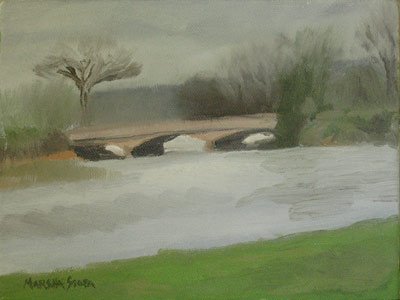 Just outside the southern city limit of Brevard, North Carolina, you cross the French Broad River. One of the main rivers in Western North Carolina, the French Broad plays a major role in the history of the region, as all rivers do. It was a means of transportation for the Native Americans before it saw the first settlements of Europeans, primarily the Scots-Irish fleeing religious persecution in Scotland.
Just outside the southern city limit of Brevard, North Carolina, you cross the French Broad River. One of the main rivers in Western North Carolina, the French Broad plays a major role in the history of the region, as all rivers do. It was a means of transportation for the Native Americans before it saw the first settlements of Europeans, primarily the Scots-Irish fleeing religious persecution in Scotland.The flat valleys along the French Broad are still farm land along much of the river's course. I crossed the French Broad numerous times as I drove throughout the region, especially as I traveled farther west. But I didn't have to go far to find a beautiful, quiet expanse of farm fields. Less than three miles from the entry to the subdivision where I stayed was a picturesque, tranquil scene rimmed on two sides by distant mountains and depending on the time of day, traversed by a herd of cattle.
As I drove to and from town on an almost daily basis, I looked for places I could set up and paint. I considered the parking lot of a large church at a far corner of the fields, but it was too far away. I tried a corner opposite the fields on what appeared to be a substation for the local telephone company. But that angle faced directly west and I was squinting into the sun and telephone lines early in the afternoon. The road shoulder was narrow and I didn't want to be a hazard. Finally, I stopped at a daycare center adjacent to the fields and asked if I could set up and paint near the road, far from children's activity.
For my first 6 X 8 inch painting that afternoon I isolated a section of field with the mountains behind. This time I felt a bit more ready to tackle the values of the mountains and pushed myself to work fast and not overthink the image. One of the primary reasons I was so attracted to this view was because of the interesting patterns of the cattle herd I frequently saw. What I didn't realize is that cattle have schedules. The field was empty while I painted, and empty for most of the rest of the afternoon. The herd appeared and started to move across, from left to right in this view, as I finished the second painting and was packing to leave. I have reference photos, so there are still cows in my painting future.

I then turned 90 degrees and squinting into the late afternoon sun in the west, decided to paint the field on the opposite side of the road from the first painting, my side of the road. You can just see the road and the bridge where it crosses the French Broad, in the top right side of the canvas. The river is not extremely wide at this point.
It's very interesting how juicy and fluid oil paint becomes when the sun is beating down on your canvas. No shade nearby and too breezy to set up my unstable plein air umbrella. But the sun lighting up the corn fields in front of me was too luminous to pass up. I was even visited by several curious horses, separated by a thin wire fence.I'm not sure if that is a house or barn behind the trees in the distance. Metal roofs are common in this part of the country so that roof was indeed, white.
As much as I enjoy painting the garden vignette, a large part of me leans toward the traditional genre of long-range-view landscape painting. On the other hand, it's highly intimidating to be faced with a 180 degree scene of intense beauty and attempt to translate a small slice of it into paint on canvas. My left brain always argues to include more of the scene, more details, while my right brain, my visual brain, is working feverishly to reduce what my eyes are seeing to simple, elegant images. Suffice it to say that after an afternoon of painting in the sun, your eyes aren't the only part of you that is glazed over.

1 comment:
Post a Comment